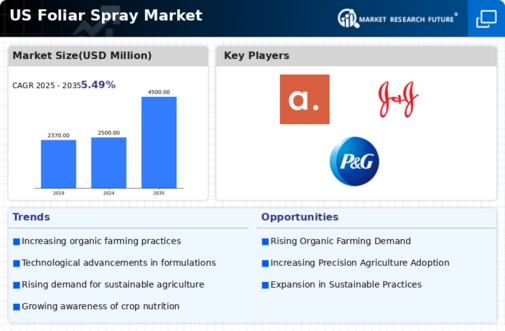Rising Demand for Organic Produce
The increasing consumer preference for organic produce is a notable driver in the foliar spray market. As health-conscious consumers seek out organic fruits and vegetables, farmers are compelled to adopt practices that align with these preferences. Foliar sprays, particularly those derived from natural sources, are gaining traction as effective solutions for nutrient delivery and pest management. According to recent data, the organic food market in the US is projected to reach approximately $70 billion by 2025, indicating a robust growth trajectory. This trend is likely to propel the foliar spray market, as growers look for compliant products that enhance crop quality while adhering to organic standards. The foliar spray market is thus positioned to benefit from this shift towards organic farming practices, as it offers innovative solutions that meet the evolving demands of consumers.
Expansion of Specialty Crop Cultivation
The expansion of specialty crop cultivation in the US is emerging as a vital driver for the foliar spray market. Specialty crops, including fruits, vegetables, and ornamental plants, often require specific nutrient management strategies to thrive. Foliar sprays are particularly effective for these crops, as they allow for precise nutrient delivery and can address specific deficiencies quickly. The USDA reports that the specialty crop sector has been growing steadily, with an estimated value of over $50 billion. This growth is likely to increase the demand for foliar spray products tailored to the unique needs of specialty crops. Consequently, the foliar spray market is positioned to capitalize on this trend, as growers seek innovative solutions to enhance the health and productivity of their specialty crops.
Increased Focus on Crop Health and Yield
The growing emphasis on maximizing crop health and yield is a critical driver for the foliar spray market. Farmers are increasingly recognizing the importance of nutrient management in achieving optimal crop performance. Foliar sprays provide a targeted approach to delivering essential nutrients directly to plants, which can lead to improved growth and higher yields. Recent studies indicate that foliar applications can enhance nutrient uptake by up to 30%, making them an attractive option for growers. As the agricultural sector in the US continues to face challenges such as climate change and soil degradation, the foliar spray market is likely to see heightened demand for products that support sustainable farming practices. This focus on crop health not only benefits farmers economically but also contributes to food security and sustainability efforts.
Technological Innovations in Agriculture
Technological advancements in agricultural practices are significantly influencing the foliar spray market. Innovations such as precision agriculture and smart farming techniques are enabling farmers to apply foliar sprays more efficiently and effectively. The integration of drones and automated systems for spraying has been shown to enhance application accuracy, reduce waste, and improve crop yields. As of 2025, the precision agriculture market in the US is expected to surpass $10 billion, suggesting a strong inclination towards technology-driven solutions in farming. This trend is likely to foster growth in the foliar spray market, as farmers increasingly adopt these technologies to optimize their operations and maximize productivity. The ability to monitor crop health and nutrient needs in real-time further underscores the potential for foliar sprays to play a crucial role in modern agricultural practices.
Regulatory Support for Sustainable Practices
Regulatory frameworks promoting sustainable agricultural practices are emerging as a significant driver for the foliar spray market. The US government has been increasingly supportive of initiatives aimed at reducing chemical inputs in farming, thereby encouraging the use of environmentally friendly alternatives. Foliar sprays that comply with these regulations are likely to see increased adoption among farmers seeking to align with government policies. The USDA has introduced various programs to support sustainable farming, which may include incentives for using organic and biodegradable foliar products. This regulatory support is expected to bolster the foliar spray market, as it creates a favorable environment for the development and use of sustainable formulations. As farmers adapt to these regulations, the demand for compliant foliar sprays is anticipated to rise, further driving market growth.














Leave a Comment